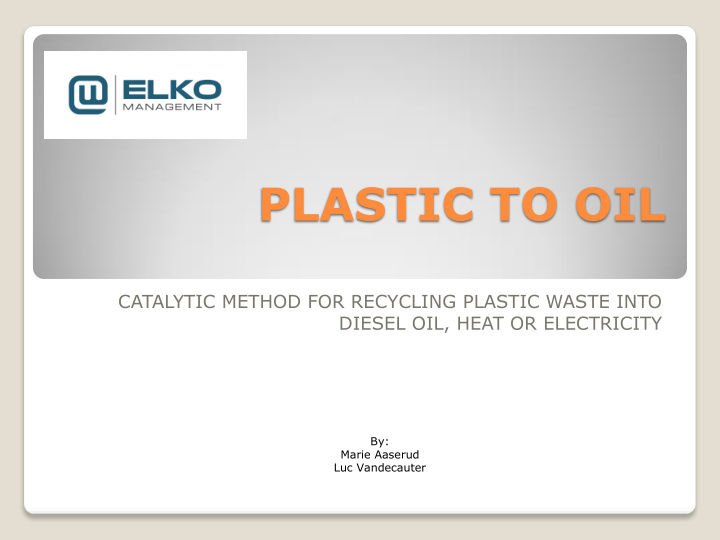



PLASTIC TO OIL CATALYTIC METHOD FOR RECYCLING PLASTIC WASTE INTO DIESEL OIL, HEAT OR ELECTRICITY By: Marie Aaserud Luc Vandecauter
Our group has developed innovative, ecological and economical sustained systems to recycle biomass and waste, including plastics and tyres into Energy. The system proves to be very effective in reducing the cost of sorting and treating all non-recyclable packaging. The system enables recycling of the largest group of plastic waste, i.e. polyethylene(PE), polypropylene(PP) and polystyrene(PS). This innovative technology is protected by patents in both the European Union and the USA. It is an unusual ecological and economical attractive way to utilize plastic waste. It has been implemented in many countries and is also used by a large stock exchange-listed company in the USA. INNOVATIVE
Plastic waste can come directly from a landfill site or waste sorting plants. The system processes waste mixed in any proportions of PP, PE and PS. The recycled waste may be wet or dirty, it may carry thermal-sprayed metallic or coloured imprints. The waste may be multi-coloured or have various structures and thickness. It is obviously a far more ecological and economical solution than incineration. This technology transforms all types of plastics into various energies including mineral oil. Our processes are free of gaseous emission. Except for the cooling system, no use of water, which could lead to water pollution. No chemical additives, which perfectly meets the European requirements on the environment. ECOLOGICAL
The system has a modular construction, the scale of an installation may be changed according to the needs, which allows for recycling any quantity of waste. The energy needed for the process is obtained from the recycled waste. Waste recycling using this technology significantly reduces landfill space. Plastic materials are transformed into liquid fuel. The recycling process taking place in the system consist of de-polymerisation and is based on an innovative patented solution. The system is not an incineration plant and the produced liquid fuel may be transported and put to use in other places. This is neither a pyrolysis technology nor a system for plastic re-granulation. ECOLOGICAL
Bad example Good example Pyrolysis: Our Catalytic system: No need to prepare raw material, Preparing raw material is necessary: shredding, Process temperature 380°C homogenization, No emerge gases: Process temperature 200°C – 800°C H²S, NH³ Emerge gases: HCL, HF, H²S – hydrogen sulfide HCN NH³ - ammonia Closed system, HCL – chloride • Heat recovery and use to own needs or sale, HF – iodide • Gases recovery C1-C4 and use them to heat HCN – cyanide • the reactor during normal work – lower Pyrolysis ashes contain heavy metals, • operating costs, Final products contain toxic and carcinogenic • Experience in own plant, • compounds, Final product parameters like normal diesel • Low energy efficiency. • Lifetime 20 years. • ECOLIGICAL
INDUSTRIAL By multiplying the units we • will recycle and produce oil on an industrial scale.
FINAL PRODUCT BASIC PARAMETERS pH: 6,5 – 7 • Flow temperature: -20)C • Flush point: >62°C • Density in 15°C: 790-810kg/m³ • Sticky in 20°C 3,5-4,5mm²/s • Cetane number: >64 (according • to test results from independent laboratory) Final product can be used: Note: quality produced components is • • inextricably linked to the quality of the batch. The presence of chlore in As diesel the feed, nitrogen or sulfur may As heating oil prevent the use of resulting products To produce electricity for certain applications.
CONTACT US: www.elkomanagement.com info@elkomanagement.com
Recommend
More recommend